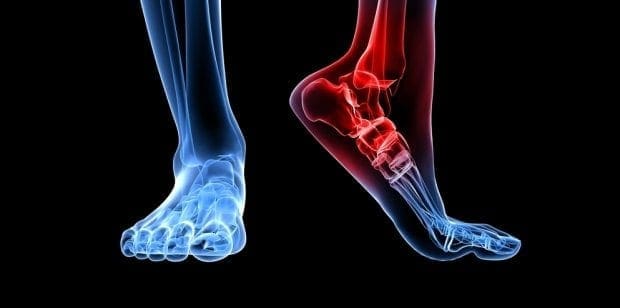There�s a disease that�s often mistaken for another illness or disorder at first since it can cause flu-like symptoms, fatigue, loss of appetite and other problems associated with different health concerns. But it�s much more serious than the flu. In fact, it�s a progressive, debilitating disease that affects about one in every 4,000 people. I�m talking about mitochondrial disease.
Mitochondrial disease is a disorder that�s caused by failure of the mitochondria, which results from�DNA mutations that affect�how someone�s genes are expressed. What do mitochondria do, and how does their failure impact someone�s health? Mitochondria are specialized �compartments� found within almost every single cell of the human body (all except red blood cells). They�re often nicknamed �the powerhouse� of cells because they help with the process of creating usable energy (ATP) within cells, but mitochondria also have numerous other roles too.
According to the United Mitochondrial Disease Foundation, mitochondria are responsible for creating more than 90 percent of the energy needed to sustain the human body (plus the bodies of most other animals too), but what might surprise you is that about 75 percent of their job is dedicated to other important cellular processes besides energy production. (1,�2) Without proper mitochondrial functioning, we wouldn�t be able to grow and development from the time of infancy or have enough energy to carry out bodily functions as adults like digestion, cognitive processes and maintaining cardiovascular/heartbeat rhythms.
There�s still a lot to learn about how mitochondrial disease develops, what risk factors might make people susceptible, how it should be properly diagnosed and what the best treatment options are. Researchers believe that the�aging process itself is at least partially caused by deteriorating mitochondrial functions, and today we know of many different disorders that are tied to abnormal mitochondria processes (cancer, some forms of heart disease and Alzheimer�s, for example).
That being said, because there isn�t a cure for mitochondrial disease at this time, the goal is to help control symptoms and stop progression as much as possible through a healthy lifestyle and in some cases medications.
Natural Treatment for Mitochondrial Disease
1. See a Doctor for Early Treatment and Management
Early diagnoses and treatment of mitochondrial disease might be able to help stop cellular damage from worsening and causing permanent disabilities. Early interventions for young children can also help improve functions like talking, walking, eating and socializing.
It helps many patients manage their symptoms when they become educated on mitochondrial diseases and know what to expect.�Mitochondrial disease is unpredictable and can change shape day to day, so the more a patient understands his or her�own disease, the better that person�can prepare for symptoms. Symptoms can worsen and progress if they�re ignored so ongoing support and early recognition are key.
2. Get Plenty of Rest
People with mitochondrial disease often experience chronic fatigue, which makes it hard to go about life normally. Things like digestion, bathing, walking and working can be hard to keep up with, so getting plenty of sleep and not overexerting yourself is important.
Many people aren�t�be able to exercise, at least not vigorously, due to trouble breathing and low energy, and require more sleep than a healthy person would to manage symptoms and stay healthy. It�s also helpful to prevent fatigue by eating regularly and avoiding fasting, plus trying to stick to a normal sleep/wake cycle as much as possible.
�
�
3. Eat an Anti-Inflammatory Diet
Digesting the foods we eat is one of the hardest processes the body goes through, using a high percentage of our daily energy to metabolize nutrients, send them to our cells and discard of waste afterward. A lot of people with mitochondrial disease experience gut trouble, problems with appetite and eating regularly, and uncomfortable symptoms caused during digestion of foods, which is why a nutrient-dense diet that�s low-processed is most beneficial.
The more processed someone�s diet is (high in things like sugar, artificial ingredients, refined carbohydrates and hydrogenated fats), the harder the�organs have to work to extract nutrients and get rid of toxic waste that�s left over. It�s also important to consume plenty of nutrients to help prevent even more fatigue from developing, such as B vitamins, iron, electrolytes and trace minerals.
For some people with mild forms of mitochondrial disease, getting enough rest and eating a healing diet filled with anti-inflammatory foods is enough to help manage their symptoms and improve quality of life. Some helpful tips for improving mitochondrial disease symptoms with a healthy diet include:
Avoid fasting/going too long without eating, and avoid trying to lose too much weight (both can worsen fatigue). Eat small, frequent meals to help with digestion.
Have a healthy snack before bedtime (especially one with a form of complex carbohydrates) and upon waking up.
Healthy fats seem to be helpful for some people with mitochondrial diseases, so in some cases extra fat can be taken in the form of MCT oil. (3) Each person should test his or her�reaction to fats since some do better with a lower fat diet, while others must be careful about low-fat diet risks. Some people�need to reduce almost all fats and consume more carbohydrates to avoid excess free fatty acids and low-energy ADP production.
Iron-rich foods should be limited and levels monitored since iron�can be�harmful if it�s overaccumulated. Avoid taking supplements with iron unless you�re being monitored by a doctor, and try to limit�vitamin C foods around a meal rich in iron, since this boosts iron absorption even more. (4)
4. Avoid High Amounts of Stress
Stress worsens inflammation and fatigue while also hindering immune function. Stressful situations should be avoided, and many patients find they feel better when purposefully reduce stress by incorporating stress relievers like meditation, journaling, relaxing outdoors, etc. Thermal regulation is also critical for people with mitochondrial disease, which means avoiding stressing situations like very cold or very hot temperatures.
5. Build Immunity to Prevent Infections
People with mitochondrial disease are more susceptible to infections and other illnesses, so it�s crucial to keep immunity up with a healthy lifestyle. Many different natural antiviral herbs might be able to help prevent frequent infections. Tips for�helping to improve immunity include:
conserving energy and pacing out�activities to avoid fatigue
getting outdoors and maintaining a comfortable environment/temperature as much as possible
Avoiding exposure to lots of germs, bacteria and viruses that trigger an illness (such as in childcare settings, schools or certain work environments)
staying hydrated and eating a nutrient-dense diet
taking high-quality supplements, including: omega-3 fatty acids, a multivitamin/B vitamin complex, and antioxidants like vitamin C or vitamin E. There�s also evidence that CoQ10,�a fat-soluble antioxidant used for energy production, can be helpful and is safe for most people with mitochondrial dysfunction. (5)
Facts About Mitochondrial Disease
Mitochondria disease is actually a term used to group together hundreds of different disorders that all stem from dysfunctions of mitochondria, each one with its�own exact cause and symptoms.
It�s estimated that about one in 4,000 people has a type of mitochondrial�disease, which is considered progressive in nature and currently without a cure. (6)
When mitochondria stop working properly, the result is that less energy in the form of ATP is generated within cells, and therefore the whole body usually suffers. Cells can become damaged or die all together, sometimes leading to a complete failure of different organs and entire bodily systems.
Damaged mitochondria can affect how the�brain, heart, liver, bones, muscles, lungs, kidneys and endocrine systems (hormones) work. (7)
Children are more likely to have mitochondrial disease than adults are, although more cases of adult-onset mitochondrial disease are now being diagnosed. Infants and children might show signs of slow or abnormal development, trouble speaking or hearing, fatigue, and lack of coordination at a young age.
Mitochondrial disease can develop at any age (although it shows up in children most often) and is often mistaken for another illness or disorder at first since it can cause flu-like symptoms, fatigue, loss of appetite and other problems associated with different health concerns.
Some people experience debilitating symptoms from mitochondrial disease, like not being able to talk or walk normally, but others live a mostly normal life as long as they take care of themselves carefully.
Most patients� symptoms fluctuate over the course of their disease, from severe to being barely noticeable. However, some people develop mitochondrial disease at a young age that causes disabilities that last their whole lifetimes. Older people can develop diseases related to mitochondrial dysfunction, including dementia and Alzheimer�s disease. (8)
Mitochondrial disease runs in families to some extent, but it�s also caused by other factors. Family members with the same disorder can experience vastly different symptoms even if they have the same genetic mutations.
How Mitochondria Work
It takes about 3,000 genes to make one mitochondria, and only about 3 percent of those genes (100 of the 3,000) are allocated for making ATP (energy) within cells. The remaining 95 percent of genes found within mitochondria are tied to cell formation and differentiation, functions of the metabolism, and various other�specialized roles.
Mitochondria are needed to:
build, break down and recycle the molecular �building blocks� of cells
make new RNA/DNA within cells (from purines and pyrimidines)
produce enzymes required to make hemoglobin
help cleanse the liver and detoxify the body by boosting removal of substances like ammonia
for cholesterol metabolism
creating and balancing hormones (including estrogen and testosterone)
carrying out various neurotransmitter functions
protection against oxidative damage/free radical production
breaking down fats, proteins and carbs from our diets to be turned into ATP (energy)
As you can see, mitochondria are extremely important for development and overall health, since they help us grow from an embryo to an adult and form new tissues throughout our lives. All of the roles mitochondria have help slow down the effects of aging and defend us from disease development.
Symptoms of Mitochondrial Disease
Symptoms of mitochondrial disease can manifest in many different ways and vary in terms of intensity depending on the specific person and�which organs are affected. When a large enough number of cells in one organ are damaged, symptoms become noticeable. Some common mitochondrial disease symptoms�and signs include: (9)
fatigue
loss of motor control, balance and coordination
trouble walking or talking
muscle aches, weakness and pains
digestive problems and gastrointestinal disorders
trouble eating and swallowing
stalled growth and development
cardiovascular problems and heart disease
liver disease or dysfunction
diabetes and other hormonal disorders
respiratory issues like trouble breathing normally
higher risk for strokes and seizures
vision loss and other visual problems
trouble hearing
hormonal disorders including a lack of testosterone or estrogen
higher susceptibility to infections
It�s possible for mitochondrial disease to affect only one organ or group of tissues in some people, or to affect entire systems in others. Many people with a mutation of mtDNA display a cluster of symptoms that are then classified as a specific syndrome. Examples of these types of mitochondrial diseases include: (10)
Kearns-Sayre syndrome
chronic progressive external ophthalmoplegia
mitochondrial encephalomyopathy with lactic acidosis and stroke-like episodes
myoclonic epilepsy with ragged-red fibers
neurogenic weakness with ataxia and retinitis pigmentosa
many people also experience symptoms that cannot be easily classified, so they don�t fit into one particular category
Whether they�re grouped together under a specific condition/syndrome or not, research suggests that people with mitochondrial dysfunctions experience higher rates of these symptoms and illnesses than people with mitochondrial diseases:
drooping of the eyelids (ptosis)
autoimmune disorders like Hashimoto�s disease�and fluctuating encephalopathy
disorders that affect the eyes, including external ophthalmoplegia,�optic atrophy, pigmentary retinopathy�and diabetes mellitus
exercise intolerance
irregular heartbeat rhythms and functions (cardiomyopathy)
seizures
dementia
migraines
stroke-like episodes
autism � a�child with autism may or may not have a mitochondrial disease (11)
mid- and late-pregnancy loss (miscarriages)
The Causes of Mitochondrial Disease
Mitochondrial disease is the result of spontaneous mutations in mtDNA or nDNA. This leads to altered functions of either proteins or RNA molecules that live within mitochondria compartments of cells.�In some cases, mitochondrial disease only affects certain tissues during the time of development and growth, which are referred to as �tissue-specific isoforms� of mitochondrial dysfunction. Researchers don�t fully understand yet why people are affected so�differently by mitochondrial problems and what leads to experiencing symptoms within various organs/systems.
Because mitochondria perform hundreds of different functions in different tissues throughout the entire body, mitochondrial diseases produce a wide spectrum of problems, making proper diagnoses and treatment hard for doctors and patients. (12)
Even when researchers are able to identify that an identical mtDNA mutation occurred in two different people using genetic testing, both people still might not have identical symptoms (the term for diseases like this that are caused by the same mutation but cause different symptoms is �genocopy� diseases). Mutations in different mtDNA and nDNA can also cause the same symptoms (known as �phenocopy� diseases).
Risk Factors for Mitochondrial Diseases
The exact causes of mitochondrial disease aren�t entirely known at this time. Risk factors for mitochondrial disease and related illnesses, however, include: (13)
Having nuclear gene defects that are inherited in an autosomal recessive or autosomal dominant manner (they�re transmitted by maternal inheritance more often but can be passed on from a parent). (14)�Mitochondrial disease has an approximate recurrence risk of one in 24 within the same family.�Parents can be genetic carriers of a mitochondrial disease and not show symptoms of their own but still pass the defective gene onto their children.
High levels of inflammation. Inflammation has been linked to multiple degenerative diseases as well as the aging process itself, and mitochondrial alterations play a central role in these processes. (15)
Other compounding medical conditions. For example, in adults many �diseases of aging� have been found to have defects of mitochondrial function, including type 2 diabetes, Parkinson�s disease, atherosclerotic heart disease, stroke, Alzheimer�s disease and cancer.
In some cases, patients receiving immunizations show abnormal mitochondrial symptoms for the first time, or symptoms become worse. But it still isn�t totally clear if the immunizations can be blamed and how they�re involved. Some evidence suggests children should not receive vaccinations if they have underlying mitochondrial disorders that make them exponentially more vulnerable to vaccine damage. (16,�17)
Some evidence shows that inflammation and �medical stress� � caused by an unhealthy lifestyle or conditions like fevers, infections, dehydration, electrolyte imbalances and other illnesses � can activate the immune system, which worsens metabolic disorders and mitochondrial functions.
Mitochondrial Disease Takeaways
Mitochondria disease is actually a term used to group together hundreds of different disorders that all stem from dysfunctions of mitochondria, each one with its own exact cause and symptoms.
Mitochondrial disease is often mistaken for another illness or disorder at first since it can cause flu-like symptoms, fatigue, loss of appetite and other problems associated with different health concerns. It�s a progressive, debilitating disease that affects about one in every 4,000 people.
Some people experience debilitating symptoms from mitochondrial disease, like not being able to talk or walk normally, but others live a mostly normal life as long as they take care of themselves carefully.
To treat mitochondrial disease, see a doctor for early treatment and management, get plenty of rest, eat an anti-inflammatory diet, avoid high amounts of stress, and build immunity to prevent infections.
Symptoms include fatigue; loss of motor control, balance and coordination; trouble walking or talking; muscle aches, weakness and pains; digestive problems and gastrointestinal disorders; trouble eating and swallowing; stalled growth and development; cardiovascular problems and heart disease; liver disease or dysfunction; diabetes and other hormonal disorders; respiratory issues like trouble breathing normally; higher risk for strokes and seizures; vision loss and other visual problems; trouble hearing; hormonal disorders including a lack of testosterone or estrogen; and higher susceptibility to infections.
Risk factors include nuclear gene defects that are inherited in an autosomal recessive or autosomal dominant manner, high levels of inflammation, and other compounding medical conditions. Some evidence shows that inflammation and �medical stress� � caused by an unhealthy lifestyle or conditions like fevers, infections, dehydration, electrolyte imbalances and other illnesses � can activate the immune system, which worsens metabolic disorders and mitochondrial functions.

 neuropathy was also commonly diagnosed in patients with obesity, regardless if they had normal blood sugar levels when compared with lean, control patient participants. This same study additionally confirmed that the rate of neuropathy increased in individuals with pre-diabetes and diabetes, leading the researchers to conclude that pre-diabetes, diabetes and obesity are possible metabolic drivers of peripheral neuropathy.
neuropathy was also commonly diagnosed in patients with obesity, regardless if they had normal blood sugar levels when compared with lean, control patient participants. This same study additionally confirmed that the rate of neuropathy increased in individuals with pre-diabetes and diabetes, leading the researchers to conclude that pre-diabetes, diabetes and obesity are possible metabolic drivers of peripheral neuropathy.












